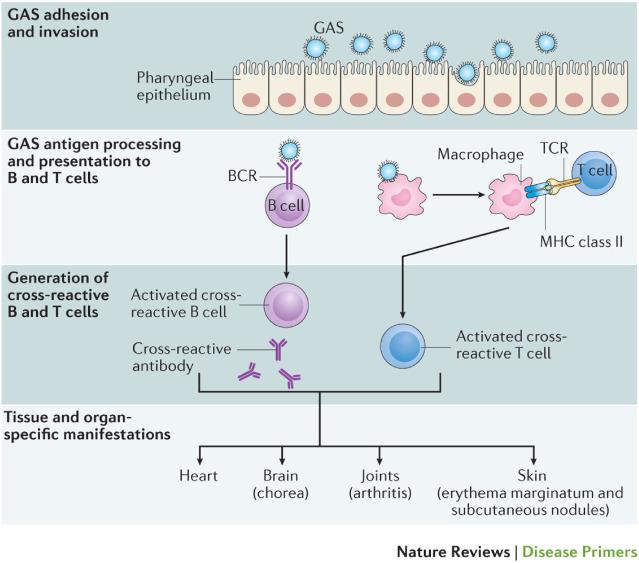Physical Address
304 North Cardinal St.
Dorchester Center, MA 02124
Research grants to MWC: (a) HL35280 and HL56267 from the National Heart Lung and Blood Institute and National Institute of Mental Health Bench to Bedside; (b) grants from the Oklahoma Center for the Advancement of Science and Technology and the American Heart Association. Declaration of financial interest: MWC is a chief scientific officer and consultant at Moleculera Labs, a company offering diagnostic testing for antineuronal autoantibodies in children with autoimmune movement and neuropsychiatric disorders.
Research grants to LG: FAPESP-2885-6 from “Fundaçao de Amparo a Pesquisa do Estado de Sao Paulo” and CNPQ-620418 from “Conselho Nacional de Desenvolvimento Científico e Tecnológico (CNPq),” Brazil.
A complete and comprehensive understanding of the pathogenesis of acute rheumatic fever (ARF) has eluded scientists for decades. ARF is a multiorgan inflammatory disorder affecting the heart (carditis), joints (arthritis and arthralgia), brain (Sydneham's chorea), skin (erythema marginatum), and subcutaneous tissue (subcutaneous nodules). Rheumatic heart disease (RHD) is characterized by typical heart valve lesions, classified clinically as regurgitation and stenosis, and histopathologically by the presence of pathognomonic granulomatous Aschoff bodies.
It is well established that ARF follows infection with group A Streptococcus (GAS), otherwise known as Streptococcus pyogenes, through an inflammatory process in susceptible individuals, and that RHD occurs as a result of a severe initial or multiple episodes of ARF. Researchers have attempted to unravel the inflammatory basis of the pathogenesis of ARF, focusing on humoral and cellular immune responses with molecular mimicry as the central mediator of cross-reactivity with GAS. Molecular mimicry is where a foreign antigen shares sequence or structural similarities with self-antigens. Many questions remain, including whether skin infection can trigger ARF, whether groups C and G streptococci might also lead to the disease, and whether there is a genetic basis to susceptibility to ARF.
In this chapter, we outline the current understanding of the pathogenesis of ARF. We begin with a broad overview and describe the mediators of autoimmune response, and then delve more deeply into molecular mimicry, pathogenesis of carditis and RHD, the role of T cells in RHD, pathogenesis of Sydenham's chorea, and finally genetic susceptibility.
Pharyngeal infection with GAS leads to activation of cells of the innate immune system. Neutrophils, macrophages, and dendritic cells phagocytose the bacteria, and then present antigens to T cells, in turn leading to activation of humoral and cellular immune responses. The immune response becomes cross-reactive with human tissues in susceptible individuals—this is the driving mechanism of ARF. The B- and T-cell response leads to antibody production and CD4+ T-cell activation. These cross-reactive antibodies and T cells are generated through the process of molecular mimicry whereby antigenic epitopes are shared between host and bacteria. This autoimmune process is believed to be the basis of all of the clinical manifestations of ARF: carditis is caused by both cross-reactive antibodies and T cells, arthritis by immune complex deposition, chorea by antibody binding to neuronal cells and the skin, and subcutaneous manifestations by a delayed hypersensitivity reaction ( Fig. 2.1 ).

Become a Clinical Tree membership for Full access and enjoy Unlimited articles
If you are a member. Log in here